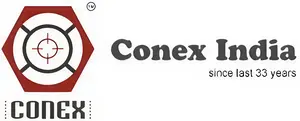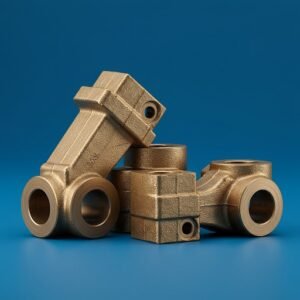Copper Casting, Copper High Conductivity Casting Parts and Components
Copper Casting, Copper High Conductivity Casting Parts and Components
 We are one of the leading manufacturers and exporters of Copper Casting, Copper High Conductivity Casting Parts and Components from India. We have been supplying high-quality Copper-based components to the world market for many decades. Our products are widely recognized for their superior conductivity, durability, and precision. With over three decades of experience, we specialize in producing custom Copper castings that meet international standards such as ASTM, DIN, BS, JIS, and IS. Our state-of-the-art manufacturing facilities, combined with a highly skilled workforce, enable us to deliver products that cater to a wide range of industries, including electrical, automotive, aerospace, and industrial machinery.
We are one of the leading manufacturers and exporters of Copper Casting, Copper High Conductivity Casting Parts and Components from India. We have been supplying high-quality Copper-based components to the world market for many decades. Our products are widely recognized for their superior conductivity, durability, and precision. With over three decades of experience, we specialize in producing custom Copper castings that meet international standards such as ASTM, DIN, BS, JIS, and IS. Our state-of-the-art manufacturing facilities, combined with a highly skilled workforce, enable us to deliver products that cater to a wide range of industries, including electrical, automotive, aerospace, and industrial machinery.
 We specialize in Copper connectors, Copper terminals, Copper lugs, cable terminals, Copper cable terminals, Copper switchgear contacts, Copper Transformer connectors, Spade terminals , Spade connectors (Aluminum Bronze as well as Copper) for transformer Bushings, Copper threaded studs etc.
We specialize in Copper connectors, Copper terminals, Copper lugs, cable terminals, Copper cable terminals, Copper switchgear contacts, Copper Transformer connectors, Spade terminals , Spade connectors (Aluminum Bronze as well as Copper) for transformer Bushings, Copper threaded studs etc.
Our commitment to quality, faster turnaround times (4-6 weeks), and exceptional customer support sets us apart from competitors. We offer customized solutions, including tailored packaging with customer labels or logos, ensuring a seamless experience for our global clients.
Material Grades
We work with a variety of Copper grades to meet diverse application requirements. Some of the most commonly used grades include:
- C10100 (Oxygen-Free Electronic Copper)
- C10200 (Oxygen-Free Copper)
- C11000 (Electrolytic Tough Pitch Copper)
- C12200 (Phosphorus-Deoxidized Copper)
- C14500 (Tellurium Copper)
- C17200 (Beryllium Copper)
Each grade is selected based on its specific properties, such as conductivity, strength, and corrosion resistance.
 Methods of High Conductivity Copper Casting
Methods of High Conductivity Copper Casting
Based on the document, here are the primary methods used for producing high conductivity copper castings:
1. Sand Casting of Copper
In this traditional method, molten copper is poured into sand molds that contain a cavity of the desired shape. This method is versatile for producing complex geometries with relatively low setup costs, though the surface finish may require additional finishing operations.
2. Investment Casting (Lost Wax Casting) of Copper
This precision method creates highly detailed castings with excellent surface finishes. A wax pattern is created, coated with ceramic material, and then the wax is melted out, leaving a cavity into which molten copper is poured. This method achieves tighter tolerances and better surface quality than sand casting.
3. Copper Die Casting
Die casting uses reusable metal molds (dies) into which molten copper is forced under high pressure. This method enables high production rates with excellent dimensional accuracy and surface finish, making it ideal for high-volume production of smaller components.
4. Copper Centrifugal Casting
In this process, molten copper is poured into a rotating mold. The centrifugal force pushes the metal against the mold wall, creating dense, homogeneous castings with minimal porosity. This method is particularly effective for creating cylindrical parts like bushings and pipes where high conductivity is crucial.
5. Continuous Casting of Copper
This method involves pouring molten copper into a water-cooled mold to produce continuous lengths of material. It’s particularly effective for producing bars, rods, or tubes of consistent quality with excellent conductivity properties.
6. Copper Permanent Mold Casting:
Copper permanent mold casting is a precision casting process where molten Copper is poured into a reusable metal mold, typically made of steel or cast iron. This method ensures excellent dimensional accuracy, a smoother surface finish, and improved mechanical properties compared to sand casting. Permanent mold casting is ideal for producing high-volume, complex Copper components such as electrical connectors, motor housings, and plumbing fittings. The process enhances strength and conductivity while minimizing porosity, making it a preferred choice for industries requiring high-performance Copper alloys.
Each casting method is selected based on factors including:
- The complexity and size of the desired part
- Required production volume
- Necessary tolerances and surface finish
- Cost considerations
- Specific conductivity requirements
For the highest conductivity applications, careful material selection (such as oxygen-free copper grades C10100 and C10200) is combined with appropriate casting methods and post-casting treatments to ensure optimal electrical performance.
Material Grades
| Grade | Description |
|---|---|
| C10100 | Oxygen-Free Electronic Copper |
| C10200 | Oxygen-Free Copper |
| C11000 | Electrolytic Tough Pitch Copper (ETP Copper) |
| C12200 | Phosphorus-Deoxidized Copper |
| C14500 | Tellurium Copper |
| C17200 | Beryllium Copper |
Methods of High Conductivity Copper Casting
| Method | Description |
| Sand Casting | Molten copper poured into sand molds; suitable for complex shapes. |
| Investment Casting (Lost Wax) | Uses wax patterns for high-precision, detailed castings. |
| Die Casting | Molten copper forced into reusable metal molds under high pressure. |
| Centrifugal Casting | Molten copper poured into rotating molds, creating dense castings. |
| Continuous Casting | Produces long sections like bars, rods, or tubes. |
Manufacturing Capabilities
- Processes: Sand Casting, Investment Casting, Die Casting, Centrifugal Casting, Continuous Casting.
- Machinery: Induction Melting Furnaces, CNC Machining Centers, Grinding & Polishing Equipment, Quality Testing Instruments.
- Surface Finishes: As-Cast, Machined, Polished, Electroplated, Powder Coated.
Typical Parts Produced from Copper
| Part | Application |
| Electrical Connectors- Copper transformer studs, Copper transformer spade terminals, Copper Switchgear parts | Power transmission and electronics |
| Bushings & Bearings – Copper bushings, Transformer bushings | Industrial machinery and automotive |
| Heat Exchanger Components | HVAC and power generation |
| Valve Bodies & Fittings | Fluid control systems |
| Pump Impellers | Water and chemical processing |
| Gears & Sprockets | Mechanical assemblies |
Material Properties
| Property | C10100 | C10200 | C11000 | C12200 |
| Conductivity (%IACS) | 101 | 100 | 100 | 98 |
| Tensile Strength (MPa) | 220 | 210 | 200 | 220 |
| Hardness (HRB) | 45 | 40 | 50 | 55 |
| Corrosion Resistance | Excellent | Excellent | Excellent | Good |
Size-Dimensional Chart
| Part Type | Diameter (mm) | Length (mm) | Weight (kg) |
| Electrical Connector | 10-50 | 20-100 | 0.1-2 |
| Bushing | 20-100 | 50-200 | 1-10 |
| Valve Body | 50-200 | 100-500 | 5-50 |
| Pump Impeller | 100-300 | 200-600 | 10-100 |
Performance Metrics
- Conductivity: ≥ 98% IACS
- Tensile Strength: 200-400 MPa
- Hardness: 60-120 HRB
- Corrosion Resistance: Excellent
Industries Served
- Electrical and Electronics
- Automotive
- Aerospace
- Industrial Machinery
- Renewable Energy
- Marine
Frequently Asked Questions (FAQs)
- Q: What is the maximum size of parts you can produce?
- A: Up to 500 mm diameter and 1000 mm length.
- Q: Do you offer custom packaging?
- A: Yes, with customer labels or logos.
- Q: What is the lead time for orders?
- A: Typically 4-6 weeks, expedited options available.
- Q: Do you provide material certifications?
- A: Yes, material test certificates are provided.
Why Choose Us?
- Fast Turnaround: 4-6 weeks with expedited options.
- Global Experience: Decades of international service.
- Customization: Tailored solutions for unique requirements.
- Quality Assurance: Compliance with global standards.
- Customer Support: Dedicated team for seamless communication.
- Custom Packaging: With client branding options.
Contact us today for a quote, a detailed brochure, or any inquiries. Our team is ready to assist you in meeting your manufacturing needs with precision and efficiency!





